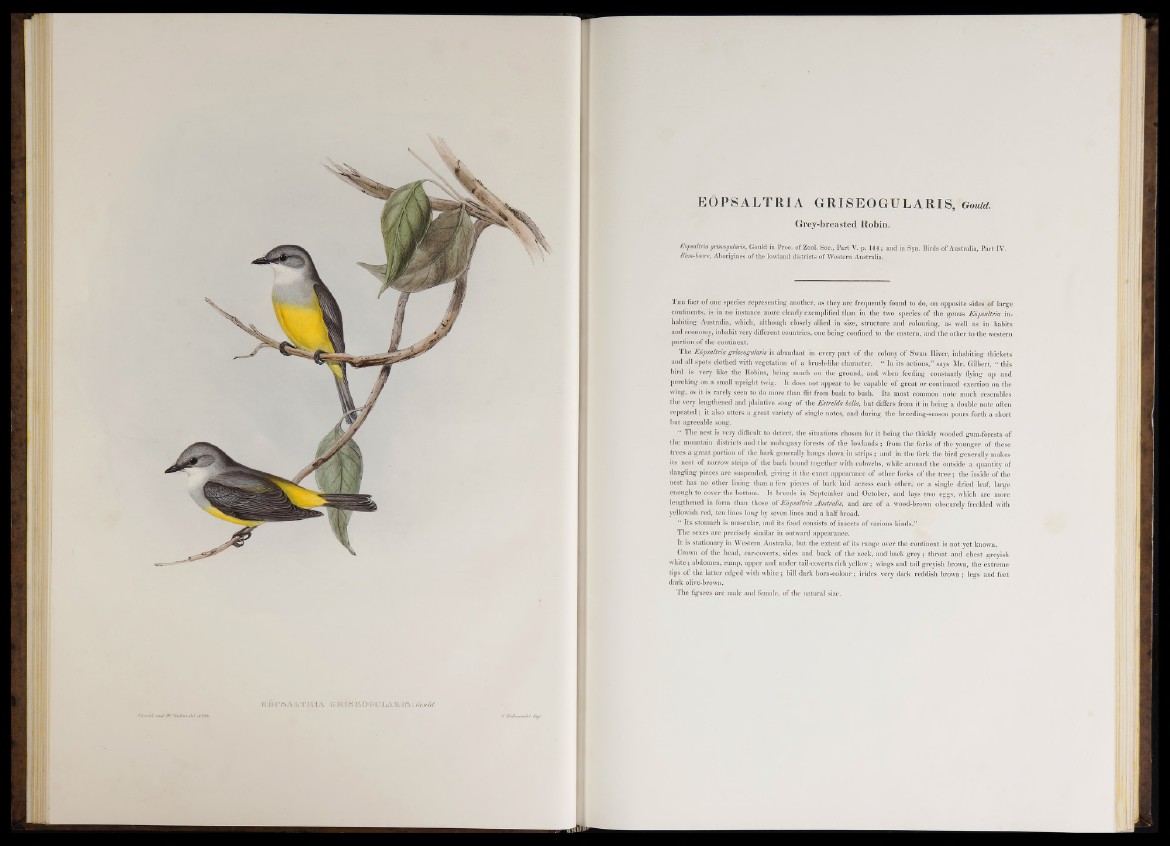
EOPSALTRIA GRISEOGULARIS, Gould.
Grey-breasted Robin.
Eopsaltria griseogularis, Gould in Proc. of Zool. Soc., Part V. p. 144; and in Syn. Birds of Australia, Part IV.
Bam-boore, Aborigines of the lowland districts of Western Australia.
T he fact of one species representing another, as they are frequently found to do, on opposite sides o f large
continents, is in no instance more clearly exemplified than in the two species o f the genus Eopsaltria inhabiting
Australia, which, although closely allied in size, structure and colouring, as well as in habits
and economy, inhabit very different countries, one being confined to the eastern, and the other to the western
portion o f the continent.
The Eopsaltria griseogularis is abundant in every part of the colony o f Swan River, inhabiting thickets
and all spots clothed with vegetation of a brush-like character. “ In its actions,” says Mr. Gilbert, “ this
bird is very like the Robins, being much on the ground, and when feeding constantly flying up and
perching on a small upright twig. It does not appear to be capable o f great or continued exertion on the
wing, as it is rarely seen to do more than flit from bush to bush. Its most common note much resembles
the very lengthened and plaintive song o f the Estrelda della, but differs from it in being a double note often
repeated; it also utters a great variety o f single notes, and during the breeding-season pours forth a short
but agreeable song.
“ The nest is very difficult to detect, the situations chosen for it being the thickly wooded gum-forests of
the mountain districts and the mahogany forests of the lowlands ; from the forks of the younger o f these
trees a great portion of the bark generally hangs down in strips; and in the fork the bird generally makes
its nest o f narrow strips o f the bark bound together with cobwebs, while around the outside a quantity of
dangling pieces are suspended, giving it the exact appearance o f other forks o f the tr e e ; the inside of the
nest has no other lining than a few pieces o f bark laid across each other, or a single dried leaf, large
enough to cover'the bottom. It breeds in September and October, and lays two eggs, which are more
lengthened in form than those o f Eopsaltria Australis, and are of a wood-brown obscurely freckled with
yellowish red, ten lines long by seven lines and a half broad.
“ Its stomach is muscular, and its food consists o f insects o f various kinds.”
The sexes are precisely similar in outward appearance.
It is stationary in Western Australia, but the extent of its range over the continent is not yet known.
Crown o f the head, ear-coverts, sides and back o f the neck, and back g r ey ; throat and chest greyish
white; abdomen, rump, upper and under tail-coverts rich yellow; wings and tail greyish brown, the extreme
tips o f the latter edged with white; bill dark horn-colour; irides very dark reddish brown ; legs and feet
dark olive-brown.
The figures are male and female, of the natural size.